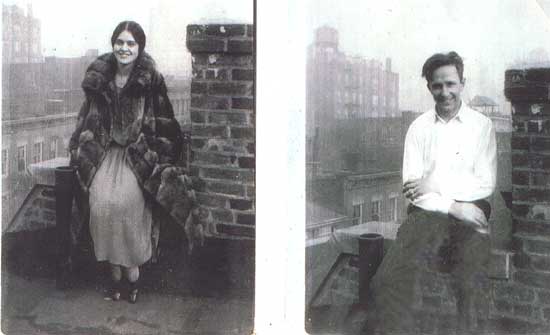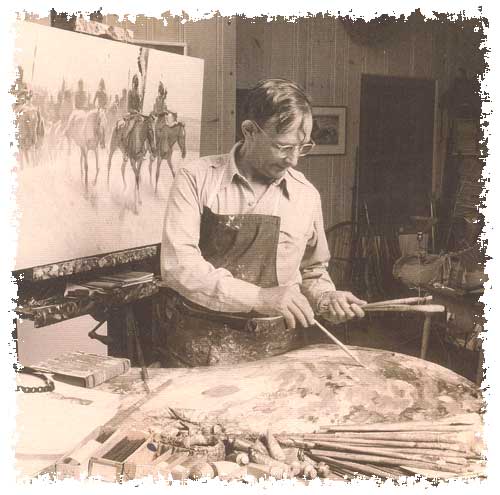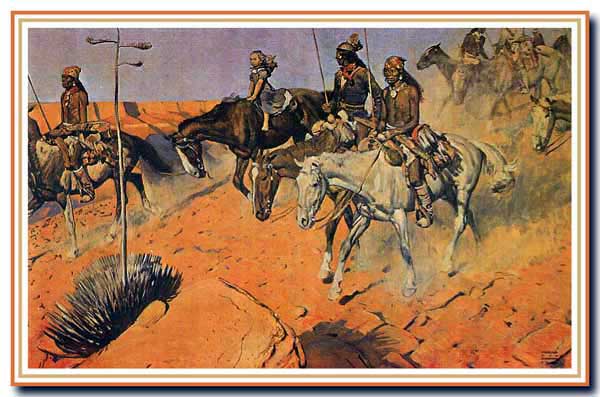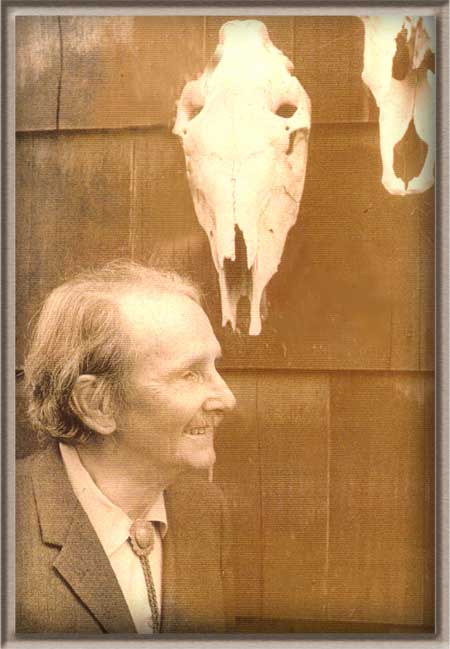The Image Makers 4
Von had always had a love affair with
horses; I've not come across a single mention of Rockwell ever
having been on one, John Ford (who claimed to have once "been a
cowboy and punched cows for awhile," sounded as unconvincing as the
few existing photos of him on horseback. One description was "he
looked like a sack of walnuts." But he didn't need to know
how to ride. In his medium the horse served as Metaphor, source
of excitement, and powerful image.
When they were both founding members for The
Famous Artist's School, Norman spent an afternoon with Von. Von had
convinced himself that with his method of "comparative anatomy" that
anyone could paint horses in motion as he did. I don't think he
convinced Norman! During his many years with the "slicks”, Von
really had no imitators. The closest thing to it was to come later,
when after the magazines died out most of Westport's illustrators
actually moved west and became "western artists."
Russell and Remington also were both bound up
in the mystique of the horse. Charlie maintained it was impossible
for someone to paint a horse if he was not a rider -- a student of
the horse, and my father believed that too.
Von's First Image
Indeed, his very selfhood had to do with a
chalk drawing of horse he had drawn in class, and his teacher
admired it, so she took him from classroom to classroom showing it
to the entire school. "Before that I was nobody. Then all of a
sudden, I was somebody… I became the kid who could draw horses. I
could never repay that teacher, but she gave me an identity. And I
knew I wanted to be an artist after that."
Another one of his favorite stories was about
two fire horses that were running loose in the streets of Alameda
following the San Francisco earthquake of 1906…"I cried when they
took my horses away. Those were the first horses I ever thought
I owned."
Soon after Von and Reb bought their house on
Deadman's Brook in Westport, a stable was added and two horses and a
pony were in residence. My mother was a fine rider, and my older
brother and I learned at an early age. Von still wore a Stetson and
was determined not to forsake his claim as a "westerner".

Reb and Von
Although his knowledge of the horse was already
encyclopedic, he would still use this little "herd" to make
occasional sketches, either in the barn or out in the direct
sunlight. He did the same with water flowing in Deadman's Brook.
Everything had an "anatomy": trees, the earth, even clouds, I not
only had the opportunity as a child to see him create his
illustrations in the studio, I was invited on many of these
sketching expeditions.
Having been introduced to out-of-door sketching
(oil painting, actually) at an early age, I can attest that
something happens in the process that is almost mystical. The
experience of being outdoors as opposed to recreating a color
photograph of an "outdoor scene" is key to the process.
We did our outdoor painting on 8" by 10" pieces
of illustration board. They were painted directly in oil, and the
board was not sized in any way. Just the pristine white. Because the
total area is so small, no pencil sketch was deemed necessary. You
just squeezed out the oil paint on a small wooden hand-held palette,
put the cardboard on your easel, looked at your scene and started.
Turpentine in a little metal cup hitched to your palette, served as
your medium.
The beauty of this
process is that, unlike a color photograph which takes less than a
second, that for the half, three quarter, or hardly more than an
hour, your subject matter is in constant motion. You are
playing a game of tag with the light, the shadows, the clouds...you
become aware of the top light, the reflection of the sky… the bushes
and the distant trees might change in softer ways, might go from
bluish hues to golden. Harsher contours change in more dramatic
ways. The sky is the most dramatic actor of all. You are always
playing catch up...and you are in the vital process of learning.
Perhaps you are learning about change, about Nature.
Maybe...about life?
How To Draw Cowboys And Indians
In May of 1948 Von was getting all these
western serials to do for the Post (John Ford was making
movies from some of them) and I had just gotten my driver's license.
It seemed like a good time to take a real sketching trip, camp out
and paint Monument Valley (where Ford was shooting the movies) and
then go south to Apache country (where James Warner Bellah was
locating his short stories.)
After sketching in Taos, where Von had painted
briefly in the twenties, we headed for Monument Valley. We stayed at
Harry Goulding's Trading Post, and it is a great pleasure to say,
after reading Ron Davis's biography, that Harry and his wife "Mike"
had no horror stories to tell about "Mr. John" and that he (Mr.
John) had no complaints about them. Of course, they weren't
obliged to act. Also, Ford's filmic safaris were of vast
benefit to the Navajo tribe during lean times.
Like John Wayne, Harry Goulding sure as hell
knew about Von's paintings for The Saturday Evening Post, and
was delighted to see Von there with his son, actually sketching his
beloved valley. It was fascinating to hear the two of them talk
about the early days, their involvement with Indians, (Harry
spoke Navajo) and Von's memorable trip on horseback with a
Navajo guide in the late teens.
After three or four days sketching in the
stately Valley, we drove south, where the country (“Bellah Country")
got meaner and the desert more inhospitable, and while Von tended to
relegate Remington to the ranks of the Eastern Western
painters, "Bud" claims my admiration for his description of the
country that unfolded before us. (Indeed, though he was never near
Monument Valley, he was with General Crook during the period
Bellah fictionalized): “Let anyone who wonders why the troops do not
catch Geronimo, but travel through a part of Arizona and Sonora,
then he will wonder that they even try. Let him see the desert
wastes of sand devoid of even grass, bristling with cactus...let the
sun pour down white hot upon the blistering sand about his feet and
it will be plainer."
When we reached our destination, we discovered
that the “old" Fort Grant no longer existed. In fact, as I was to
learn years later, in the words of General Crook's aide, John G.
Bourke, this “most forlorn parody of a military garrison...there
would be very little use in attempting to describe Old Fort Grant,
Arizona, partly because there was really no fort to describe..."
Such was the actual fort from which Bellah's
fictional cavalrymen rode forth to smite the fiends incarnate, the
hellish Apache led by the arch-enemy-Geronimo. There are relatively
few photographs of Apaches of the period, but Von searched them out.
They wore white man shirts, vests and the mid-calf leather legging
with the turned-up toe.
As for US Cavalry uniforms and equipment, Von
tended to look to Remington because he "was there." This worked okay
up to a point, but to my mind his biggest gaffe was making the issue
dark blue coats (“blouses") too "powder blue", and the "sky-blue
kersey" pants too green. While Remington might have approached that
color scheme in a few later paintings in a specific light, it just "ain't
right."
Ford didn't have to worry about shades or
color. His cavalry uniforms came from the costume department, and
they were usually pretty good. His main concern was that they look
worn, and he was right, because they usually didn't. It must
be remembered that Harold von Schmidt was considered a paragon of
research and authenticity from the thirties to the sixties. In
Hollywood, a make-up man's idea of "going through hell on a
battlefield" was to tear the guy's shirt diagonally, just above the
elbow, and smudge his cheekbone ever-so-artfully with burnt cork.
All this was well before the reenactment groups with their accuracy
fetishes.
Von knew "raggedy." His soul was
raggedy. Like John Ford, (and unlike James Warner Bellah,) he
instinctively sided with the underdog: with the Indians, the
immigrants, with "the raggedy kids from the orphanage."

Harold painting what would
appear in James W. Bellah's "The Last Fight" Saturday Evening Post,
October 16, 1948
Custer Shows Himself
When, in the late sixties, I decided to tackle
a monumental painting of the Custer fight on the Little Big Horn, it
was both a challenge to my Old Man to get back to work, and to see
if I could combine my own talent of "jack-knife-historian" and a
(sometimes) "realist" painter. To do something no one had done
before -- to muster the facts...and try to GET IT RIGHT...
This quest, called Here Fell Custer,
which I imagined would take about nine months took five and a
half years, and my respect for my father and others who dared to
tackle historical depictions in limited amounts of time increased
immeasurably! As a serious history painter, I can't ascribe to John
Ford's ironic dictum, "when the fact becomes legend, print the
legend." What are referred to as "Brady" photographs of the Civil
War raise some interesting points. While Brady took most of the
studio portraits, the scenes of the death and destruction, were
actually taken by his assistants, notably Timothy O'Sullivan and
Alexander Gardener. Most people when trying to sound knowledgeable
about authentic depictions of the "old west" invariably recite the
"Two R's" without realizing they were different in almost every way.
And that, of course, they had their own antecedents: Bierstadt,
Miller, Caitlin, Bodmer, etc.
Images Of Apache Raiders
Ford, or "Pappy" as he liked to be called, (a
nice western twist on the Hemingway endearment "Papa") enjoyed the
humanizing touches my Old Man put in his illustrations. He used Von'
s image of a hostile Indian wearing a captured cavalryman's jacket
twice. Once in climactic battle in “Fort Apache”, and again
in a shot of Apaches riding with a captive child in “Rio Grande.”
But it was a perfect image that said "these guys are killers,
they've killed white soldiers...they'll do it again."
"Pappy" was an image collector. In the “captive
child" image used in “Rio Grande”, he included another telling
little detail from Von's illustration...the little girl is riding a
heavy farm horse with blinders as if it had recently been plowing in
the field. Not one in a dozen would notice these little touches, but
Ford did, and very often when he broke the rules in his cavalry
dress and gear it was for a very sound and pictorially valid reason.
The uniformity of dress was a metaphor for the
strict rigidity of a sometimes mindless military. My Old Man and
“Pappy" sometimes discussed this on the phone. Ford knew that all
those suspenders, and yellow bandanas were bogus, but didn't they
look swell in a long shot? I'm not so sure he realized that General
Crook's men on campaign actually looked more like his Welsh coal
miners in “How Green was My Valley” than what my father painted for
Bellah's Post stories.

Captive Child
artist -- Harold
von Schmidt
"The Rifleman", "Bonanza" And "Have Gun Will Travel"
But it wasn't the niceties of military dress
that would have a profound effect on both Ford and Von. It was
something else, and it would affect everything. The rapid
rise of television and the slow decline of the mass-market
magazines.
For Von it turned out to be catastrophic. His
health, never good, worsened. Fashions changed. The shrinking market
desperately sought new blood -- new faces. Von developed
diverticulosis and suffered a series of small strokes. The phone
that had stopped ringing off wall, barely rang at all.
The "magic studio" slowly became a thing of the
past.
During the mid sixties, he became sedentary. He
drank tea, ate cookies and watched a lot of his nemesis -- TV. At
night he watched “The Rifleman”, “Bonanza”, “Have Gun Will Travel.”
During the day he watched any old Western rerun he could find -- and
there were plenty. The tiny TV horses still moved with magic and
grace -- and they, blessedly didn't act.
I don't think he ever realized that he,
himself, (through John Ford and all those Saturday Evening Post
Westerns) had reinvented the Mythic West! Through their
vision, the whole pictorial west was brought to a whole new
audience, a largely unheralded accomplishment that far outstripped
Von's lifetime of honors!
True, in 1968 he was awarded the first National
Cowboy Hall of Fame Medal, and in the early seventies two books
appeared on his western painting, The Complete Illustrator
(with the Rockwell introduction,) but sadly, his painting days
were then over.
The Images Fade
When Von was eighty-six I made a wax bust of
him that was ultimately cast in bronze. As I was working, not
surprisingly, he often fell asleep. He'd been doing it for years,
and it was mostly ignored. Finally I asked him, did he dream when he
did that? If so, what did he dream about?
He gave me a quick, chilly stare with icy eyes,
affronted by my intrusion, then glanced away, confused and
embarrassed...then said...as if expelling air…
"HORSES!"
His whole past hung in that “Rosebud” moment!
I’ll never forget that…
Norman Rockwell had perfected Americana
beyond Currier & Ivies, beyond anybody, while in roughly the same
time period Von would unleash a furious pictorial dynamic
that would ultimately bridge the gap from the printed page to John
Ford's Westerns, and on into the TV age!
If Professor Davis had done his homework and
looked at a copy of the Saturday Evening Post (as Ford had
done when he wired his partner to buy the rights to the Bellah short
story that would eventually become “Fort Apache”,) and checked out
the man who painted the pictures for the other two stories in Ford's
'Cavalry Trilogy', he would have known that Harold von Schmidt was
the link.
Perhaps if he had really connected with John
Wayne's simple premise quoted on the last page of his own book, "''Pappy' was a painter with a camera" he might have used his book to
help solve that mystery which began in the dark caves of Lascaux (there
were some horses up there too) that is still unfolding today:
why some shamans like John Ford and Harold von Schmidt still make
pictures and why people will always need them.

Back To Harold von Schmidt
(Back
to Top)

The Gallery • Painting Lewis & Clark • Vonsworks Bookstore • The Alamo • Custer • Osceola • Harold von Schmidt • Links

